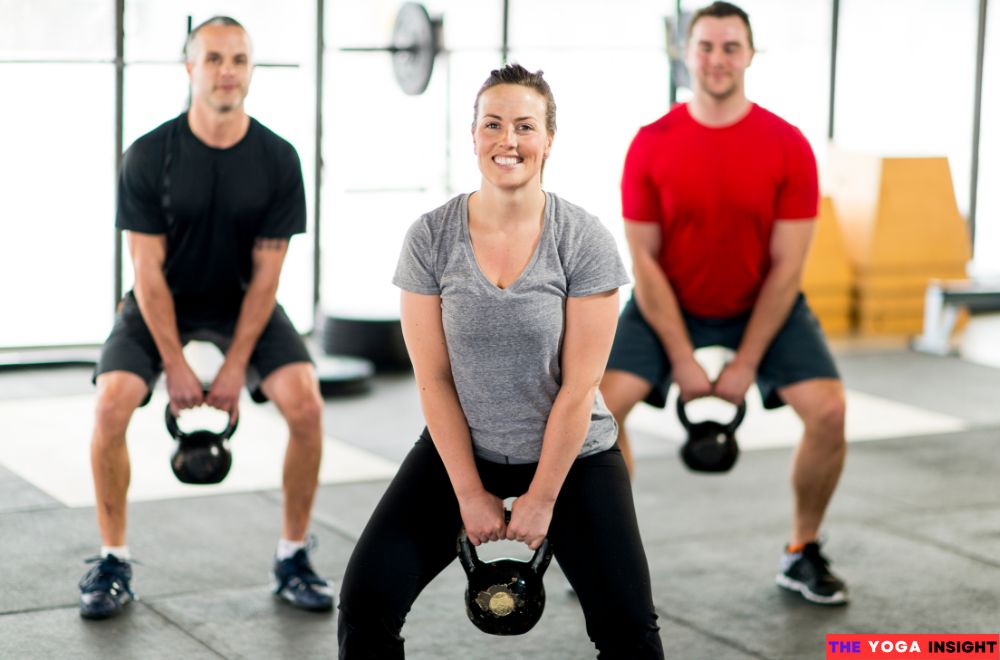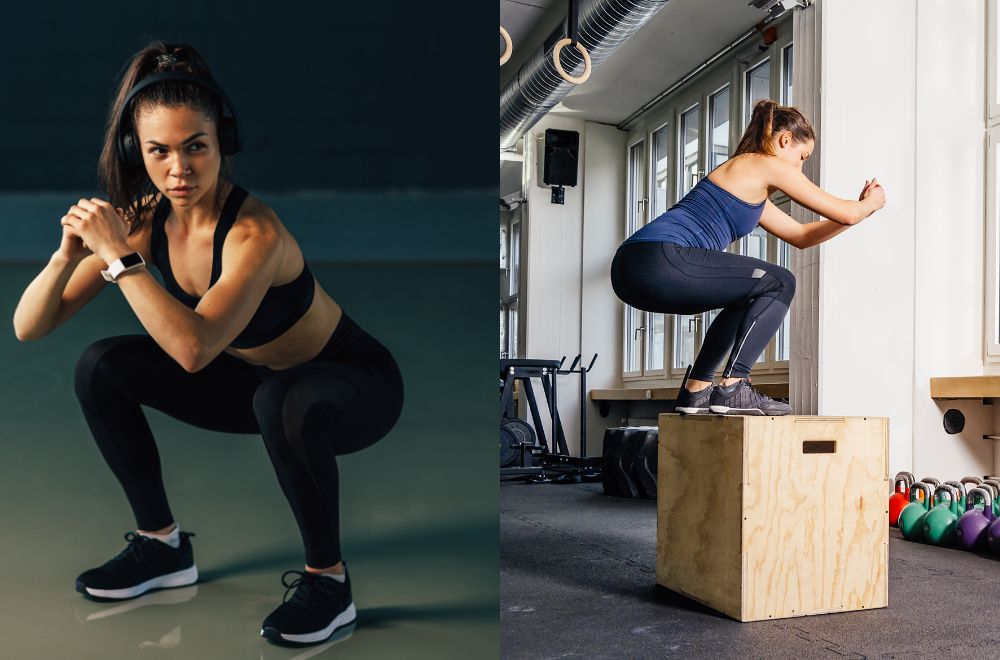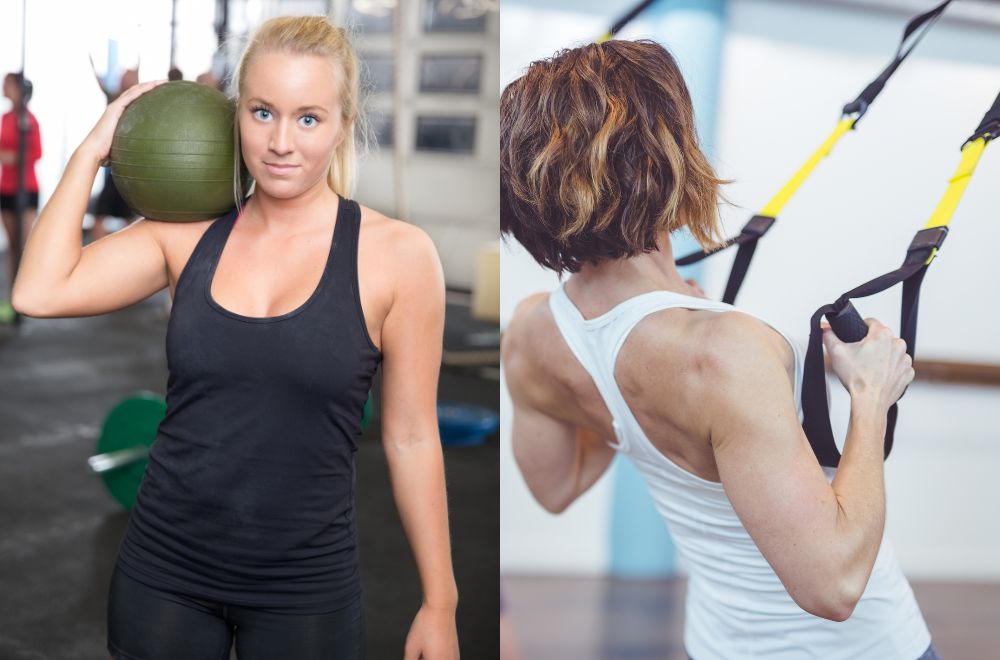Full-body workouts are like a secret weapon when it comes to burning fat. Imagine hitting multiple muscle groups in one session. This increases calorie burn and keeps your metabolism buzzing long after your workout.
Full-body workouts engage more muscles than isolated exercises. This means you’re not just targeting one area but working out your entire body. This kind of workout is efficient. With the proper routine, you can achieve a solid burn without spending hours at the gym.
Plus, it adds variety to your exercise regimen. You won’t get bored with the same old routine, and each workout can target different areas, keeping things fresh and challenging.
Benefits of Full Body Fat Burn Workouts
Boosted Calorie Burn
When you work out your whole body, you burn more calories. Engaging multiple muscle groups means more energy is expended, leading to more significant fat loss.
Increased Muscle Engagement
Full-body workouts ensure all major muscle groups are activated. This leads to balanced muscle development and helps prevent overuse injuries when focusing on just one area.
Enhanced Metabolic Rate
A full-body workout boosts your metabolism for hours after you finish. This phenomenon, known as excess post-exercise oxygen consumption (EPOC), means you continue to burn calories even when resting.
Time Efficiency
These workouts are time-savers. You don’t need to spend an hour or more on separate exercises. A well-structured full-body routine can be completed quickly while providing a comprehensive workout.
Improved Functional Fitness
Working out your entire body improves overall strength and stability. This translates into better performance in daily activities and other sports or exercises.
Full Body Fat Burn Workout
- High-Intensity Interval Training (HIIT)
- Circuit Training
- Bodyweight Strength Training
- Resistance Training with Weights
- Cardio and Strength Fusion
- Plyometric Exercises
- Functional Training
- Active Recovery Workouts
1. High-Intensity Interval Training (HIIT)

What is HIIT?
High-intensity interval Training, or HIIT, is a workout strategy alternating intense bursts of exercise and short recovery periods. It’s designed to push your body to its limits but in a manageable way. HIIT workouts are effective for burning fat because they keep your heart rate high, even after exercising. This method boosts your metabolism and helps you burn calories long after your workout.
Top HIIT Exercises for Full Body
Burpees: Burpees are a full-body exercise combining squats, jumps, and push-ups. They engage multiple muscle groups, including your legs, core, and upper body. Burpees not only increase your strength but also improve cardiovascular endurance.
Mountain Climbers: Mountain climbers are dynamic exercises that target your core, shoulders, and legs. You start in a plank position and alternately bring your knees to your chest, simulating climbing. This exercise is excellent for building core strength and increasing your heart rate.
Jump Squats: Jump squats add a plyometric element to the traditional squat. You squat down and explode upwards into a jump, then land softly and repeat. This exercise enhances lower body strength and power while burning calories.
High Knees: High knees involve running in place while lifting your knees as high as possible. This move is excellent for improving cardiovascular fitness and working your lower body.
Plank Jacks: Plank jacks combine a plank position with jumping your feet in and out. This exercise challenges your core stability and increases your heart rate.
Sample HIIT Routine
Here’s a simple HIIT routine to get you started:
- Warm-Up: 5 minutes of light jogging or jumping jacks.
- Round 1:
- 30 seconds of burpees
- 30 seconds of rest
- 30 seconds of mountain climbers
- 30 seconds of rest
- Round 2:
- 30 seconds of jump squats
- 30 seconds of rest
- 30 seconds of high knees
- 30 seconds of rest
- Round 3:
- 30 seconds of plank jacks
- 30 seconds of rest
- 30 seconds of burpees
- 30 seconds of rest
- Cool Down: 5 minutes of stretching, focusing on your legs, arms, and core.
Feel free to adjust the time intervals based on your fitness level. This routine is designed to challenge you and help you burn fat effectively.
2. Circuit Training

At its core, circuit training involves performing a series of exercises in sequence, with minimal rest in between. The goal is to keep your heart rate up and hit multiple muscle groups simultaneously. This approach is not just about burning calories. It also improves strength, endurance, and cardiovascular health all in one go.
Essential Circuit Exercises
Focus on exercises that engage various muscle groups to maximize your circuit training. Here are a few key moves:
Squats: These are great for your legs and glutes. Stand with feet shoulder-width apart, lower yourself as if sitting in a chair, then push through your heels to stand back up.
Push-ups: Excellent for the chest, shoulders, and triceps. Keep your body straight from head to heels, and lower yourself until your chest nearly touches the ground.
Burpees: This full-body exercise is perfect for cardio and strength. Begin in a squat position, jump your feet back into a plank, perform a push-up, then jump back to the squat position and leap into the air.
Lunges: These work your legs and glutes. Step forward with one leg and lower your hips until both knees are bent at about 90 degrees. Push back to the starting position and switch legs.
Planks: A solid core exercise. Hold your body straight from head to heels, supported on your forearms and toes.
How to Build Your Circuit
Creating a personalized circuit is straightforward and customizable. Here’s how to start:
- Select Your Exercises: Choose a mix of strength and cardio exercises to keep things balanced. Aim for 5-7 different exercises.
- Set Your Reps and Time: Decide how long you’ll spend on each exercise. A common approach is 30-60 seconds per exercise with a 15-30-second rest in between.
- Determine the Number of Rounds: Typically, you’ll repeat the circuit 2-4 times. Adjust based on your fitness level and goals.
- Warm-Up and Cool-Down: Begin with a 5-minute warm-up, like light jogging or dynamic stretching. End with a cool-down and stretch to prevent injury and aid recovery.
- Track Your Progress: Keep a workout log to monitor improvements and tweak your circuit as needed.
Circuit training can be a game-changer in your fitness routine, offering an efficient way to burn fat and build muscle. Customizing your circuits allows you to tailor workouts to your needs and keep your fitness journey effective and engaging.
3. Bodyweight Strength Training

Bodyweight strength training is a fantastic option for torching calories and building lean muscle. It is convenient and can also be incredibly effective for fat loss. Let’s explore why these exercises work so well and how to create a routine that keeps you motivated and moving.
Benefits of Bodyweight Exercises
Have you ever noticed how kids can play all day and stay fit without fancy gym equipment? That’s the magic of bodyweight exercises. They leverage your weight for resistance, which can be as challenging as using weights.
These versatile exercises can be done anywhere—at home, in a park, or even in your office. They help build strength and endurance, increase flexibility, and improve cardiovascular health. Plus, they engage multiple muscle groups at once, making your workouts more efficient.
Top Bodyweight Exercises
Ready to get started? Here are some powerhouse moves to include in your routine:
Lunges
Lunges are great for targeting your legs and glutes. They also help improve balance and coordination. Step forward with one leg, lower your hips until both knees are bent at a 90-degree angle, and push back to the starting position. Aim for three sets of 12-15 reps per leg.
Planks
Planks are fantastic for strengthening your core. Start by lying face down, then lift your body on your toes and forearms, keeping your body in a straight line. Hold this position as long as you can. It’s not just about holding; engage your core muscles.
Pull-Ups
Pull-ups might seem harsh, but they work your back and arms well. Find a sturdy bar, grip it with your palms facing away, and pull yourself up until your chin is over it. Aim for 3 sets of as many reps as you can manage.
Creating a Bodyweight Routine
To get the most out of your workouts, structure your routine thoughtfully. Start with a warm-up to prepare your muscles and increase your heart rate. This could be a few minutes of jumping jacks or high knees.
Next, incorporate a mix of exercises targeting different muscle groups. Combine upper body, lower body, and core exercises for a balanced routine. For example:
- Warm-Up: 5 minutes of light cardio
- Workout:
- Lunges: 3 sets of 12-15 reps per leg
- Planks: 3 sets of 30 seconds to 1 minute
- Pull-Ups: 3 sets of as many reps as possible
- Cool-Down: Stretching for 5 minutes
Aim to work out 3-4 times a week. Rest and recovery are just as important, so give your body time to heal and rebuild.
4. Resistance Training with Weights

Looking for a workout that torches calories, sculpts your body, and fits into your busy schedule? A full-body fat-burn workout might just be what you need.
This guide will explain why resistance training with weights is key for burning fat, how to do it effectively, and some essential tips to ensure you get the best results without risking injury.
Importance of Resistance Training
Resistance training isn’t just about building muscle—though that’s a perk. It plays a crucial role in boosting your metabolism and burning fat. You engage more muscle groups when you use weights, meaning your body burns more calories after your workout.
Think of it this way: lifting weights increases muscle mass, and muscle tissue burns more calories at rest than fat tissue. So, the more muscle you have, the more calories you burn throughout the day.
Effective Weight Exercises
Deadlifts: Deadlifts are a powerhouse for overall strength. They work your back, legs, and core, all while pushing your heart rate up. To perform a deadlift:
- Stand with feet hip-width apart, with the barbell in front.
- Bend at the hips and knees, grasp the barbell, and lift it by straightening your legs and back.
Bench Presses: The bench press targets your chest, shoulders, and triceps. It’s excellent for building upper body strength. Here’s how to do it:
- Lie on a bench with feet flat on the floor.
- Grip the barbell with hands slightly wider than shoulder-width.
- Lower the bar to your chest, then press it back up.
Rows: Rows are fantastic for strengthening your back and biceps. You can do them with dumbbells or a barbell. Here’s a quick guide:
- Bend over with a slight bend in your knees and a flat back.
- Pull the weights towards your torso, squeezing your shoulder blades together.
- Lower the weights slowly to complete the rep.
Tips for Safe and Effective Weight Training
Focus on Form
Proper form is essential to maximize benefits and avoid injuries. Always start with lighter weights to perfect your technique before moving on to heavier loads.
Warm-Up and Cool-down: Begin your workout with a warm-up to prepare your muscles and joints. Finish with a cool-down and stretching to aid recovery.
Listen to Your Body: Pay attention to how your body feels. If you experience pain, not just muscle soreness, it could be a sign of poor form or overexertion.
Avoid Overtraining: Give your muscles time to recover between workouts. A good rule of thumb is to train each muscle group twice weekly, allowing at least 48 hours of rest.
5. Cardio and Strength Fusion

Combining Cardio with Strength Training
Ever tried combining cardio with strength training? It’s a fantastic way to boost your workout efficiency and keep things interesting.
Like running or cycling, cardio gets your heart pumping and burns calories. Strength training, on the other hand, builds muscle and increases metabolism. When you mix the two, you get a workout that burns fat and builds lean muscle.
Think about it as a way to kill two birds with one stone. You’re not just focusing on cardio to burn calories or strength training to build muscle. You’re doing both in one go, making every minute of your workout count.
Best Fusion Exercises
Ready to try some exercises that blend cardio and strength training? Here are a few to get you started:
- Kettlebell Swings: This move combines a mighty swing with a squat, working your entire body and raising your heart rate.
- Burpees: A classic for a reason. Burpees start with a squat, add a push-up, and end with a jump. It’s a full-body workout that gets your cardio and strength in one.
- Mountain Climbers: Get into a plank position and alternate, bringing your knees to your chest. This exercise is excellent for your core and a solid cardio blast.
- Jump Squats: Start with a regular squat and explode into a jump. This exercise works your legs and boosts your heart rate.
- Battle Ropes: Use heavy ropes to make waves, slams, and circles. It’s an intense workout for both your upper body and cardio system.
Example Fusion Workout Plan
Let’s put these ideas into a workout plan you can follow.
- Warm-Up (5 minutes)
- Jumping jacks or light jogging
- Circuit 1 (10 minutes)
- 30 seconds of kettlebell swings
- 30 seconds of burpees
- 30 seconds of rest
- Repeat twice
- Circuit 2 (10 minutes)
- 30 seconds of mountain climbers
- 30 seconds of jump squats
- 30 seconds of rest
- Repeat twice
- Cool Down (5 minutes)
- Stretching or light walking
This plan blends cardio and strength exercises, helping you maximize fat burn while building muscle. Try it out and see how you feel after. It’s all about making your workouts more efficient and exciting.
6. Plyometric Exercises

Plyometrics involve high-intensity, explosive movements designed to increase strength and power. Think of them as the fuel that fires up your metabolism.
These exercises push your muscles to contract rapidly and forcefully, which helps you burn calories and build strength. They’re not just about jumping; they engage multiple muscle groups, making them practical for full-body workouts.
Top Plyometric Moves
Let’s break down some of the best plyometric exercises to reduce the heat in your fat-burning routine.
Jump Squats: Start in a squat position. Lower yourself as if sitting back into a chair, then explode upwards, jumping as high as possible. Land softly and go straight back into the squat. This move targets your quads, hamstrings, and glutes, making it a powerful full-body exercise.
Box Jumps: Find a sturdy box or platform. Stand in front of it with your feet shoulder-width apart. Bend your knees and jump onto the box, landing softly. Step down and repeat. Box jumps build explosive power and help in toning your legs and core.
Burpees: Begin in a standing position. Drop into a squat, kick your feet back into a plank, do a push-up, return to squat, and jump up. This full-body move keeps your heart rate high and torches calories.
Incorporating Plyometrics into Your Routine
Plyometrics can be intense, so start slow and focus on proper form.
Warm-Up Properly: Always start with a warm-up to prepare your muscles and reduce the risk of injury. Light jogging, dynamic stretches, or jumping jacks can get your blood flowing.
Start with Low Reps: Begin with a few repetitions of each exercise and gradually increase as you build strength and confidence. This helps in preventing overuse injuries.
Mix with Other Exercises: Combine plyometrics with other forms of exercise like strength training or steady-state cardio. This balance ensures a comprehensive workout while preventing burnout.
Rest and Recover: Give your muscles time to recover between sessions. Plyometrics are demanding, and recovery is critical to preventing injuries and improving performance.
7. Functional Training

Functional training is all about building strength and mobility for everyday activities. Instead of focusing on isolated muscles, it works on movements that mimic real-life actions. This training helps improve overall fitness and reduces the risk of injury.
The Concept of Functional Training
Functional training emphasizes exercises that engage multiple muscle groups and joints. It trains your body to handle real-world tasks more efficiently. This approach involves lifting heavy weights and improving your overall movement patterns.
Imagine you’re lifting a heavy box. Functional training prepares your body for this by strengthening the muscles used in that action. It enhances balance, coordination, and endurance, making everyday tasks more accessible and less strenuous.
Key Functional Exercises
Here are some functional exercises that pack a punch:
- Medicine Ball Slams: These are great for building explosive power. You engage your core, shoulders, and legs by slamming a medicine ball onto the ground. It’s a full-body workout in one move.
- Kettlebell Swings: This exercise boosts strength and endurance. Swinging a kettlebell helps develop your glutes, core, and grip strength. Plus, it’s excellent for improving cardiovascular fitness.
- Burpees: A classic, full-body exercise that combines squats, jumps, and push-ups. Burpees are fantastic for building strength, flexibility, and endurance.
- Battle Ropes: These are used for high-intensity interval training. Whipping ropes up and down improves cardiovascular health and works your upper body and core.
- TRX Rows: Using a TRX suspension trainer, you perform rows that target your back, biceps, and core. This exercise enhances your pulling strength and stability.
Creating a Functional Training Routine
Designing a functional training routine can be simple and effective. Here’s a quick guide:
- Start with a Warm-Up: Begin with dynamic stretches or light cardio to prepare your muscles and joints.
- Include Compound Movements: Focus on exercises that involve multiple joints and muscle groups. For instance, incorporate squats, lunges, and push-ups.
- Add Variability: Mix in different exercises to keep the routine challenging and engaging. Rotate between high-intensity moves and strength-building exercises.
- Integrate Core Work: Don’t forget to include core exercises. A strong core is crucial for overall stability and balance.
- Cool Down: Finish with stretching or yoga to help your muscles recover and prevent stiffness.
Functional training doesn’t require fancy equipment or a gym membership. You can create an effective routine using minimal equipment or just your body weight.
8. Active Recovery Workouts
Why Active Recovery Matters
Active recovery helps in muscle repair and reduces the risk of injury. It’s a less intense activity on your rest days to keep your blood flowing and aid muscle recovery.
After a challenging workout, your muscles need time to repair and rebuild. Active recovery speeds up this process by increasing blood circulation, which delivers nutrients to your muscles and helps flush out toxins.
Best Active Recovery Exercises
Incorporate exercises like yoga, light jogging, or stretching. Yoga can improve flexibility and relieve muscle tension, while light jogging keeps your muscles engaged without overloading them.
Stretching exercises, especially for the muscles worked during intense sessions, can prevent stiffness and enhance overall mobility.
How to Include Active Recovery in Your Routine
Plan active recovery days between your high-intensity workout sessions. For example, if you work out intensely on Monday and Wednesday, consider doing a yoga session or a light jog on Tuesday and Thursday.
Listen to your body. If you feel sore or tired, opting for a gentle activity can help you recover faster and prepare for your next workout.
Keep It Engaging and Effective
Mixing up your workouts and incorporating active recovery ensures you stay motivated and avoid burnout. Remember, consistency is key. Stick to your routine, and you’ll see those fat-burning results quickly.
FAQs About Full Body Fat Burn Workouts
How often should I do a whole body fat burn workout?
Aim for at least three times a week. This frequency balances exercise and recovery, promoting steady progress.
Can beginners do full-body fat-burn workouts?
Absolutely! Adjust the intensity and weights to match your fitness level. As you get stronger, you can increase the challenge.
What should I eat before a full-body fat-burn workout?
Like a banana with peanut butter, a light snack with carbohydrates and protein can provide energy without feeling too heavy.
How long will it take to see results?
With consistency and a balanced diet, you might start seeing results within a few weeks. Remember, everyone’s body responds differently.
Final Thought
A full-body fat-burning workout is a fantastic way to shed pounds, build muscle, and boost overall fitness. By incorporating HIIT, strength training, cardio, and core exercises, you’ll maximize calorie burn and improve your body’s composition.
Stick with it, adjust as needed, and watch as your hard work pays off. Remember, the key to success is consistency and dedication. So, get moving and embrace the journey to a healthier, fitter you!





